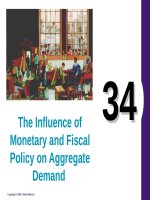Lecture Principles of microeconomics - Chapter 6: Supply, demand and government policies
Bạn đang xem bản rút gọn của tài liệu. Xem và tải ngay bản đầy đủ của tài liệu tại đây (584.38 KB, 24 trang )
Supply, Demand and
Government Policies
Chapter 6
Copyright © 2001 by Harcourt, Inc.
All rights reserved. Requests for permission to make copies of any part of
the
work should be mailed to:
Permissions Department, Harcourt College Publishers,
Supply, Demand, and
Government Policies
In a free, unregulated market system,
market forces establish equilibrium prices
and exchange quantities.
One of the things government can do is to
set price controls when the market price is
seen as unfair to either buyers or sellers.
Harcourt, Inc. items and derived items copyright © 2001 by Harcourt, Inc.
Price Ceilings & Price Floors
Price Ceiling
A legally established maximum price at which a
good can be sold. (Rent Controls)
Price Floor
A legally established minimum price at which a
good can be sold. (Price Supports for
Agriculture)
Harcourt, Inc. items and derived items copyright © 2001 by Harcourt, Inc.
Price Ceilings
Two outcomes are possible when the
government imposes a price ceiling:
The price ceiling is not binding if set above
the equilibrium price.
The price ceiling is binding if set below the
equilibrium price, leading to a shortage.
Binding means that there is an economic
impact.
Harcourt, Inc. items and derived items copyright © 2001 by Harcourt, Inc.
Harcourt, Inc. items and derived items copyright © 2001 by Harcourt, Inc.
A Price Ceiling That Is Binding...
Price of
IceCream
Cone
Supply
Equilibrium
price
$3
Price
ceiling
2
Shortage
Demand
0
75
Quantity
supplied
125
Quantity
demanded
Quantity of
IceCream
Cones
Harcourt, Inc. items and derived items copyright © 2001 by Harcourt, Inc.
A Price Ceiling That Is Not Binding...
Price of
IceCream
Cone
Supply
Price
ceiling
$4
3
Equilibrium
price
Demand
0
100
Equilibrium
quantity
Quantity of
IceCream
Cones
Effects of Price Ceilings
A binding price ceiling creates ...
shortages because QD > QS.
Example: Gasoline shortage of the
1970s
nonprice rationing
Examples: Long lines, Discrimination
by sellers
Harcourt, Inc. items and derived items copyright © 2001 by Harcourt, Inc.
The Price Ceiling on Gasoline Is
Not Binding...
Price of
Gasoline
1. Initially, the
price ceiling
is not
binding...
Supply
Price
ceiling
$4
P1
Demand
0
Harcourt, Inc. items and derived items copyright © 2001 by Harcourt, Inc.
Q1
Quantity of
Gasoline
The Price Ceiling on Gasoline Is
Binding...
S2
Price of
Gasoline
2. …but when
supply falls...
S1
P2
Price
ceiling
P1
3. …the price
ceiling becomes
binding...
4. …resulting in
a shortage.
Demand
0
Harcourt, Inc. items and derived items copyright © 2001 by Harcourt, Inc.
Q1
Quantity of
Gasoline
Rent Control
Rent controls are ceilings placed on the
rents that landlords may charge their
tenants.
Rent control can make housing more
affordable.
With a price ceiling, you cannot go
above the ceiling.
But what about the landlords?
Harcourt, Inc. items and derived items copyright © 2001 by Harcourt, Inc.
Rent Control in the Short Run...
Rental
Price of
Apartment
Supply
Supply and
demand for
apartments are
relatively
inelasticWhy is
the supply
curve vertical?
Controlled rent
Shortage
Demand
0
Harcourt, Inc. items and derived items copyright © 2001 by Harcourt, Inc.
Quantity of
Apartments
Rent Control in the Long Run...
Rental
Price of
Apartment
Because the supply
and demand for
apartments are more
elastic... What
happens in the long
run?
Supply
…rent control
causes a large
shortage
Controlled rent
Shortage
Demand
0
Harcourt, Inc. items and derived items copyright © 2001 by Harcourt, Inc.
Quantity of
Apartments
Price Floors
When the government imposes a
price floor, two outcomes are
possible.
The price floor is not binding if set below
the equilibrium price.
The price floor is binding if set above the
equilibrium price, leading to a surplus.
Think of price floors as not being able to go
below the floor.
Harcourt, Inc. items and derived items copyright © 2001 by Harcourt, Inc.
A Price Floor That Is Not Binding...
Price of
IceCream
Cone
Supply
Equilibrium
price
$3
Price
floor
2
Demand
0
Harcourt, Inc. items and derived items copyright © 2001 by Harcourt, Inc.
100
Equilibrium
quantity
Quantity of
IceCream
Cones
Harcourt, Inc. items and derived items copyright © 2001 by Harcourt, Inc.
A Price Floor That Is Binding...
Price of
IceCream
Cone
Surplus
$4
Supply
Price floor
$3
Equilibrium
price
Demand
0
80
Quantity
demanded
120
Quantity
supplied
Quantity of
IceCream
Cones
Effects of a Price Floor
A binding price floor causes . . .
a surplus because QS >QD.
nonprice rationing is an alternative
mechanism for rationing the good,
using discrimination criteria.
Examples: The minimum wage, Agricultural
price supports
State Minimum Wages
Harcourt, Inc. items and derived items copyright © 2001 by Harcourt, Inc.
The Minimum Wage
Wage
A Free Labor Market
Labor
supply
Equilibrium
wage
Labor
demand
0
Equilibrium
employment
Harcourt, Inc. items and derived items copyright © 2001 by Harcourt, Inc.
Quantity of
Labor
The Minimum Wage
Wage
A Labor Market with a
Minimum Wage
Labor surplus
(unemployment)
Labor
supply
Minimum
wage
Labor
demand
0
Quantity
demanded
Harcourt, Inc. items and derived items copyright © 2001 by Harcourt, Inc.
Quantity
supplied
Quantity of
Labor
What are some potential
impacts of taxes?
Taxes are used to raise
money for the
government.
Taxes discourage market
activity.
When a good is taxed, the
quantity sold is smaller.
Buyers and sellers share
the tax burden.
But who bears the
burdentax incidence.
Harcourt, Inc. items and derived items copyright © 2001 by Harcourt, Inc.
Copyright © 2001 by Harcourt, Inc. All rights reserved
Impact of a 50¢ Tax Levied on
Buyers...
Price of
IceCream
Cone
Price
buyers
pay
Price
without
tax
$3.30
3.00
2.80
Price
sellers
receive
Supply, S1
Equilibrium without tax
Tax ($0.50)
Equilibrium
with tax
D1
D2
0
90 100
Quantity of
IceCream Cones
Copyright © 2001 by Harcourt, Inc. All rights reserved
Impact of a 50¢ Tax on Sellers...
Price of
IceCream
Cone
Price
buyers
pay
Price
without
tax
$3.30
3.00
2.80
S2
Equilibrium
with tax
S1
Tax ($0.50)
A tax on sellers
shifts the supply
curve upward by
the amount of
the tax ($0.50).
Equilibrium without tax
Price
sellers
receive
Demand, D1
0
90 100
Quantity of
IceCream Cones
The Incidence of Tax
In what proportions is the burden of
the tax divided?
How do the effects of taxes on sellers
compare to those levied on buyers?
The answers to these questions
depend on the elasticity of demand
and the elasticity of supply.
Harcourt, Inc. items and derived items copyright © 2001 by Harcourt, Inc.
Elastic Supply, Inelastic Demand...
Price
1. When supply is more
elastic than demand...
Price buyers pay
Supply
Tax
Price without tax
Price sellers receive
3. ...than on
producers.
0
Harcourt, Inc. items and derived items copyright © 2001 by Harcourt, Inc.
2. ...the
incidence of the
tax falls more
heavily on
consumers...
Demand
Quantity
Inelastic Supply, Elastic Demand...
1. When demand is more
elastic than supply...
Price
Supply
Price buyers pay
Price without tax
3. ...than on consumers.
Tax
Price sellers receive
0
Harcourt, Inc. items and derived items copyright © 2001 by Harcourt, Inc.
Demand
2. ...the
incidence of
the tax falls more
heavily on producers...
Quantity









